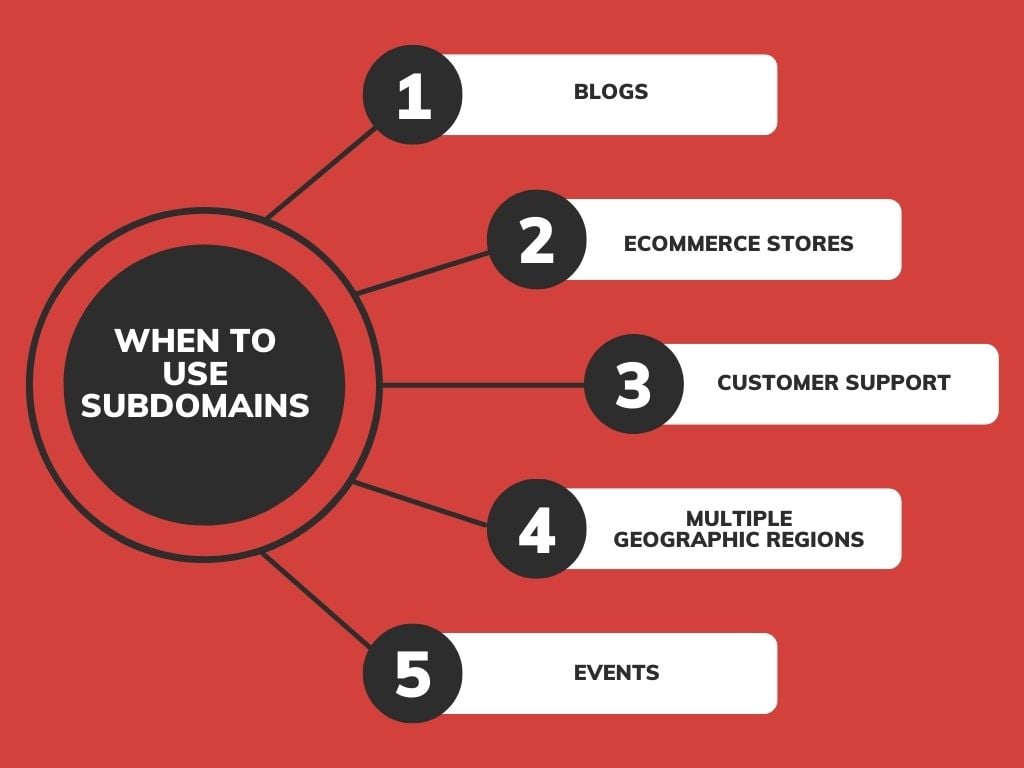Quick Links
It’s a debate that’s been raging in SEO circles for years (and doesn’t seem to be close to ending anytime soon); which one is better for SEO purposes, subdomains or subdirectories?
Many people ask whether it’s a good idea to migrate, for example, a blog or eCommerce store from a subdomain over to a subdirectory instead. Also, will it improve your SERP ranking on Google and other search engines?
More importantly, what is Google’s take on the subject, and do they crawl and rank a subdirectory (subfolder) differently than a subdomain, or vice-versa?
To answer those questions and (hopefully) clarify them for you, The HOTH presents this handy guide to the difference between a subdomain vs. subdirectory. We’ll look at what they are, how they work, and some real-world examples of the SEO differences they provide.
What is the Difference between a Subdomain vs. Subdirectory?
Subdirectory
An easy way to understand a subdirectory is to think of it as a file cabinet with different file folders. All of the folders are stored in the same cabinet, but they all have different information. (That’s why subdirectories are also known as “subfolders.”)
With a subdirectory hierarchy, the root domain URL will always be followed by the subdirectory. Using The HOTH as an example, our domain name is theHOTH.com. If you want to sign up to be a member, the subdirectory for that is theHOTH.com/signup. If you wanted to drill even deeper and become, for example, an SEO reseller, that subdirectory is thehoth.com/signup/pickrole.
You can keep adding more subdirectories ad infinitum until all the content you want is nested together. (Not that you should, but you can. More on why you shouldn’t drill down too deep later.)
Subdomain
The easiest way to think of a subdomain structure is to think of every folder as its own, separate website, with separate content management, analytics, etc. Rather than nesting inside one another, subdomains stand next to each other.
With a subdomain, instead of following the root domain URL, it precedes it. Although The Hoth doesn’t use subdomains, if we did, they would look like this:
theHOTH.com
signup.theHOTH.com
pickrole.theHOTH.com
Notice the difference? Rather than all folders stemming from the main domain URL, each has its own domain, and all are on the same level.
None of them have subdirectories (or very few if they do) as they all deal with one specific part of the overall whole and nothing more. Another way to explain it is that, instead of all folders in one file cabinet, every folder has a separate cabinet.
Subdomains are used for a variety of reasons that are similar from one organization, entity, or business to the next, including:
- Blog sites. (One of the more controversial topics of the discussion.)
- Mobile sites. Mobile content is structured far differently than desktop content.
- Intra and international websites
- eCommerce sites
- Forms of different type
An easy way to understand the difference between a subdirectory and a subdomain is that a subdirectory is another page on a website, while a subdomain is a separate website altogether.
And again, a subdirectory will always be placed after the main domain URL (theHOTH.com/blog), while a subdomain will always be placed before the main domain URL (blog.theHOTH.com)
Be Wary of Using Too Many Subdirectories
We mentioned earlier that you could use subdirectories, or subfolders, to your heart’s content if you like when structuring your website. Frankly, however, using too many subfolders is not the best idea. The reason why is twofold; user experience and search engine crawlers.
Let’s start with user experience. The best websites make it easy for visitors on the site to navigate from one page to another when they need to find different content, information, etc. However, if you use too many subdirectories, you start to interfere with that user experience and, in fact, make it more difficult with every click an internet searcher makes.
For example, the URL string can become incredibly long when too many subfolders are used. That, in turn, adds to a searcher’s confusion when on your site and creates the risk that, at the next click, they become so confused and frustrated they click away. Game over.
Search engine crawlers are next. When you use subdirectory after subdirectory, you make it more and more difficult for those crawlers to find new content on your site as they have to keep burrowing further down to find it. (Note to self; do web crawlers get tired?)
In both scenarios, your SEO suffers, you risk losing visitors, clients, and sales, and any progress you might have made with your SEO goes out the window.
For these two reasons, it’s best not to go too deep with subfolders. Use them, of course, but use them sparingly. Your backlinks will be preserved when you do, and any authority you’ve built with your domain will remain also.
Marketing a specific web page remains simple when you don’t overdo it with the subdirectories as the URL string remains short. Lastly, the page authority you create on your various subdirectories remains closely linked to the root URL domain, essential to ranking highly on Google and other search engines.
Why and When Should you Use a Subdomain rather than a Subdirectory (Subfolder)?
One of the biggest points of contention many have when discussing subdomains vs. subdirectories is that if subdirectories are better for SEO, user experience, and search engine web crawlers, why bother with subdomains?
The answer is that, in some instances, it’s better (or necessary) to have a subdomain. For example, let’s say your organization has a massive amount of online content, so much content that hosting it all on one website would simply be untenable.
In that case, having several subdomains would spread that content around and make it easier for searchers to find what they’re looking for faster.
Disney is a great example. The Disney corporation is so massive that putting all of its content on one domain would probably make it the biggest website on the planet. For that reason, Disney has broken up their content into subdomains to make it easier for its millions of customers, clients, subscribers, and searchers to find what they need.
Thus, Disney has subdomains for its videos, parks, different properties (Marvel, Pixar, Fox, etc.), and several more. By the way, all of these subdomains are treated by Google as completely separate entities or websites. The onus of linking them all together falls to Disney itself, using links from one to the other.
There are several other reasons to use subdomains, which we touched on briefly above. Below we’ll take a closer look at them, including:
Blogs
Earlier, we briefly mentioned that blogs are a main point of contention in the subdirectory vs. subdomain debate. (Some believe that they perform better when placed in a subdirectory, and stats seem to back up this claim.)
That being said, some companies and organizations choose to host their blog on a subdomain when they plan on, for example, having various content campaigns. In this case, it’s actually possible to serve a subdomain as a subdirectory and get the best of both worlds. Subdomains are also useful for building authority within a certain niche.
eCommerce Stores
Organizations that sell merchandise along with their other services and products often choose to host their eCommerce sites on a subdomain to make it easier for customers.
In some instances, depending on the type of eCommerce store they host, it’s necessary, as some use code incompatible with their main domain.
Customer Support
Depending on the product or services you sell, having your support page as a subdomain sometimes makes more sense. This choice is usually due to site structure differences but can also be due to wanting to compartmentalize the support section of their site and keep it apart from their main site.
Multiple Geographic Regions
Many businesses use subdomains to separate their organization by different national and international regions. This is often the result of language differences from one region to another but can also be for regions widely separated by space and sensibilities.
A company that has locations on the east coast, west coast, and midwest might choose to use subdomains for this very reason. One with locations in the United States, Germany, and Hong Kong would do the same.
Events
This last category usually applies to massive corporations and entities like Microsoft. They have so many events and in so many locations, having their events page as a subdomain makes more sense than a subdirectory.
A Website Can have Both Subdomains and Subdirectories
Before we go further, a quick note that a website can have both subdirectories and subdomains. Typically, however, a subdomain will have far fewer subfolders because the depth and breadth of the information will be far less than with subdirectories.
What Effect do Subdirectories and Subdomains have on SEO?
We saved the meat and potatoes of the subdirectory vs. subdomain debate for last.
Deciding which offers the best SEO results is the biggest challenge. Why? Because Google says one thing about the two categories (that they are judged equally) while statistics say another (that subdirectories get more traffic from Google and thus better SEO results and higher ranking).
Many SEO experts claim that Google’s web crawlers routinely mistake subdomains for completely different websites, which is problematic as far as SEO, page authority, links, and so forth are concerned. Most importantly, they argue that this designation as a separate website puts a big hurt on their Google page ranking.
On the other hand, Google says that, besides a slight lag-time for subdomains, their crawlers index and rank subdomains in the same way they do with subfolders. In a (now famous) video, Google search advocate John Mueller states that “Google web search is fine with using either subdomains or subdirectories.”.
However, as pointed out by various SEO experts over the last several years, statistics show otherwise. There are dozens of examples of blogs previously hosted on subdomains being transferred to a subdirectory and, almost instantly, seeing a massive increase in organic traffic.
Yes, in some cases, using subdomains is a better strategy. However, subdirectories would seem to be the better choice for smaller companies with less content, smaller budgets, and few or no, extensive verticals.
Final Thoughts on Subdomain vs. Subdirectory
For the majority of organizations and businesses, using a subdirectory hierarchy is a better choice than one based on subdomains. They provide a better user experience, ranking, and SEO results.
Subdomains still serve a very important purpose, though, especially when hosting forms, support centers, and even blogs when the goal is to rank for a different niche.
If you have more questions about the differences between subdomain vs. subdirectory, we’re here to help. Book a call with one of our SEO experts today to learn more.











